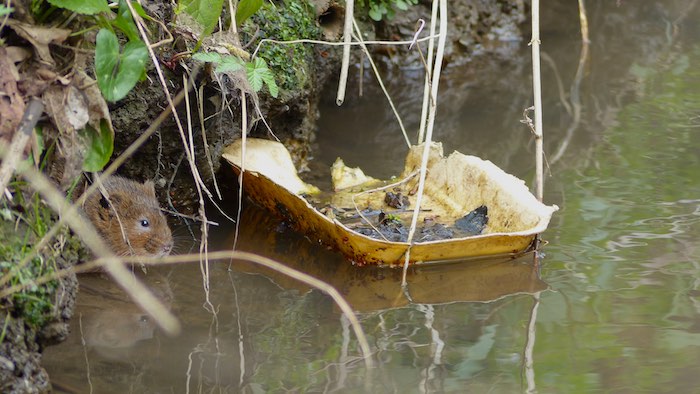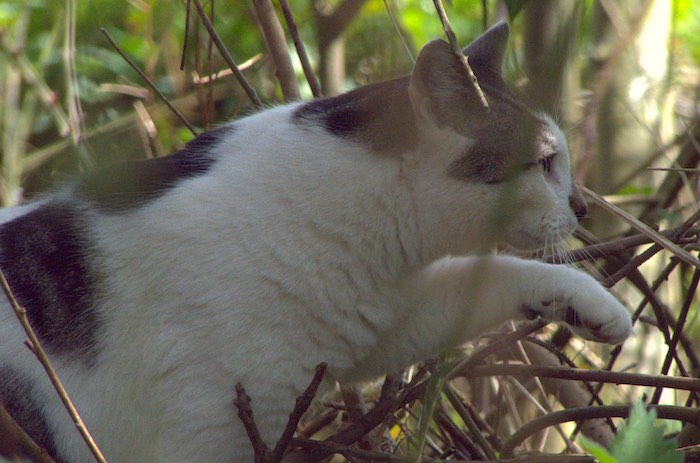The problems water voles face include development alongside habitat; rubbish thrown in streams; overzealous bank-side mowing; vegetation being strimmed and the gardening of banks in residential areas: causing habitat loss, fragmentation and further degradation.

We are the sixth most densely populated country in the world. This has caused almost constant human and dog disturbance in developed areas due to pathways too close to the water’s edge and the lack of sufficient uncut margins with lush vegetation which provide water voles with plenty of food and cover from predators.
In The Water Vole: Britain’s Most Endangered Mammal, author Christine Gregory writes:
“While water voles have generally been regarded as easy to watch at close quarters, any sudden noise or intrusion will send them into the water, or burrow, or under cover. Where there is almost constant traffic of people and dogs, the pressure can make the habitat untenable. … If they are disturbed too much they will simply move on and may be forced to settle in less than optimal habitat with fewer chances of establishing breeding colonies. … Dogs are able to search out and kill water voles, but as they rarely manage to catch either waterfowl or water voles many dog owners regard their activity in or near the water as harmless. They are not aware that their dog’s gleeful splashing and barking may be one of the very many canine intrusions that could cause a population of water voles to collapse under pressure. I was in a country park photographing a water vole that then vanished as a terrier appeared and sniffed its way along the grassy tunnels and holes at the maring of an old mining flash pond. His owner came into view and asked, “Did he disturb something — what was it?” “A water vole,” I replied. “Oh, that’s his favourite.” This encounter is typical of many I have had whilst researching this book.”
This has certainly been my experience, too. It is surprising how many people are unaware that there are water voles in their local stream.
Water voles will tolerate high levels of human disturbance in places such as streams alongside supermarket car parks where they have become habituated to humans. As Kate Long has observed:
“The site is very urban, with busy car parks on both sides and a lot of people walking across the bridge. It’s not a place people walk dogs. What we do get there sometimes is kids wading down the banks after footballs (there’s a youth centre nearby) and of course other people chucking in rubbish. But the voles seem to take that in their stride. They aren’t scared of noise and in case of a disturbance will disappear and then return in around 20 minutes or sooner.”
Dr Merryl Gelling of Spires Ecology Oxford, has advised that there is a developing school of thought on the Continent that human disturbance may deter mink, thus provide refuge for water voles and this is great news.
Kate Long has also observed mink are absent from waterways that are disturbed by humans:
“In the town centre here there are neither mink nor otters as it’s too noisy and urban. There are mink on the Llangollen canal which bypasses Whitchurch, but they tend to stay there rather than coming off and into the brook.”
Kate suspects that rats may also cause water voles to move upstream:
“A few years ago I thought the voles had gone from there, but I think what happened was that they just shifted upstream a little because there was a large population of rats that year. Now the balance seems okay-ish, and rats and voles are both present on the site. (I see rats much less than voles.)”
If we keep to pathways, dogs are kept on a lead and are not allowed into waterways, apart from designated dog bathing areas, then water voles will flourish in our cities, towns and villages across the UK and we can still have fun with our dogs. It is the level of disturbance in a waterway which causes water vole populations to move upstream, whether caused by humans, dogs or rats, and with our increased human population we have to give more consideration to our water-dwelling kin! A designated bathing area avoids constantly disrupting a water vole’s need to consume the equivalent of around 80% of its own weight on a daily basis during the breeding season (which runs from March until October). A breeding female needs to consume double that amount. Failure to do so will result in failure to thrive.

Cats predation can reduce a water vole colony. Cats that have a cheap ‘blinking’ light on their collar cuts down wildlife kills and as a bonus is much safer for the cat, too.
Now that they are scarce, water voles can be mistaken for brown rats due to their similar size and colour. Watch the Quick Guide to help you distinguish water voles, their field signs and enable them to thrive by making simple changes such as leaving the bank-side vegetation to grow during the breeding season. We can all help to make a difference whether landowner, farmer, council, school, or homeowner living alongside a waterway, lake or pond by following simple management guidelines.
Thanks to the work of wonderful water vole champions such as Dr Merryl Gelling, Kate Long, water vole reintroduction projects by Derek Gow, Wildlife Trusts, Mammal Society, and research by PTES and other conservation organizations, water voles are recolonising some counties. So it is possible to reverse the trend.
Concerns over this rapidly declining species in 1998 led to the development of a water vole recovery programme in Oxfordshire by the Berkshire, Buckinhamshire and Oxfordshire Wildlife Trust. During the period 2008 to 2016, against the backdrop of a national decline, the total water vole Local Key Areas in Oxfordshire increased more than threefold from 137 to 433km2 (please see case studies).* You can also help water voles to recover by carrying out a survey for PTES which will help their research.
* https://www.wildoxfordshire.org.uk/wp-content/uploads/2017/03/State-of-Nature-in-Oxfordshire-2017_Full-Report_FINAL_MINSIZE_COVERS.pdf
